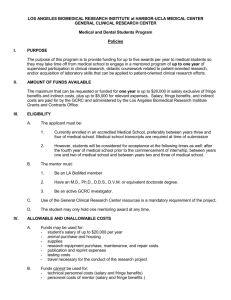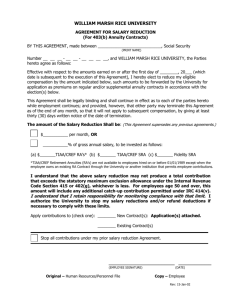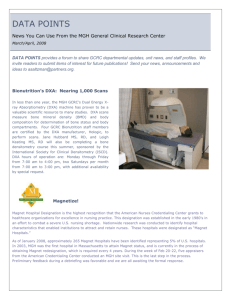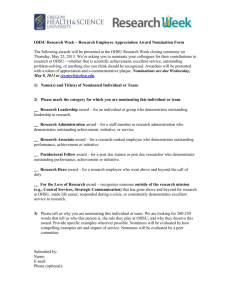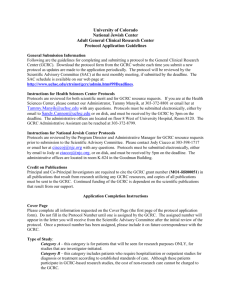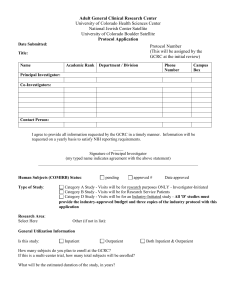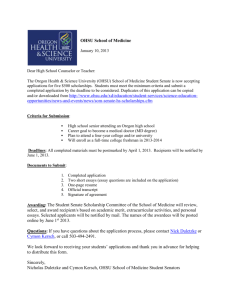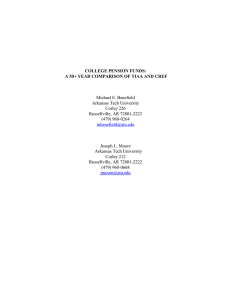here
advertisement
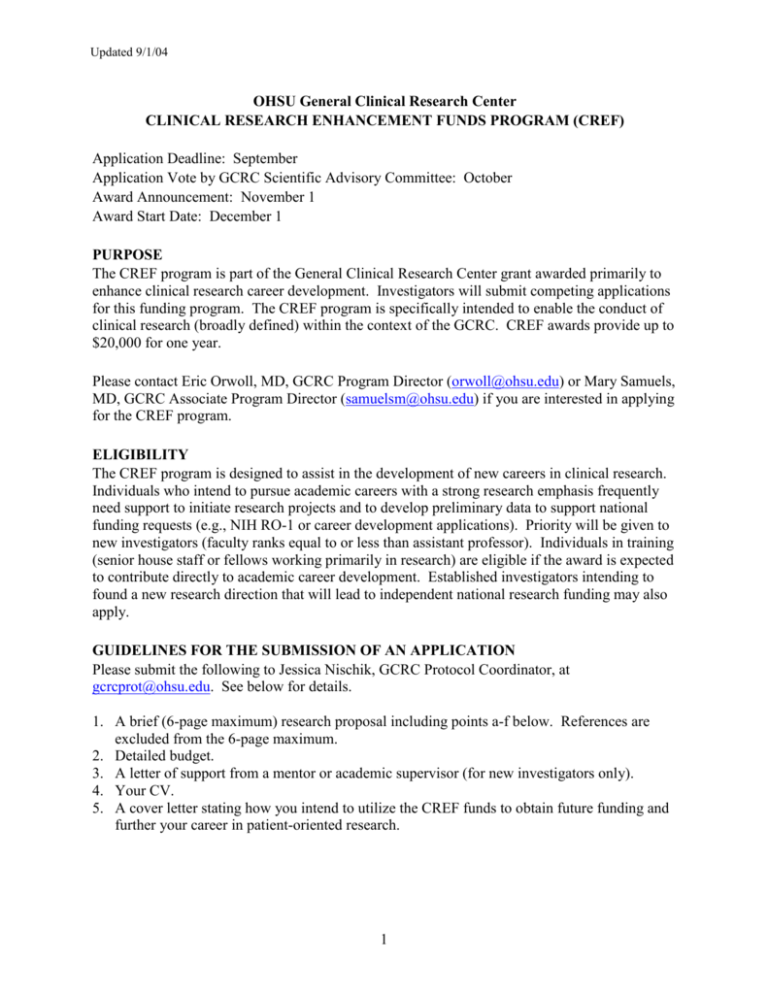
Updated 9/1/04 OHSU General Clinical Research Center CLINICAL RESEARCH ENHANCEMENT FUNDS PROGRAM (CREF) Application Deadline: September Application Vote by GCRC Scientific Advisory Committee: October Award Announcement: November 1 Award Start Date: December 1 PURPOSE The CREF program is part of the General Clinical Research Center grant awarded primarily to enhance clinical research career development. Investigators will submit competing applications for this funding program. The CREF program is specifically intended to enable the conduct of clinical research (broadly defined) within the context of the GCRC. CREF awards provide up to $20,000 for one year. Please contact Eric Orwoll, MD, GCRC Program Director (orwoll@ohsu.edu) or Mary Samuels, MD, GCRC Associate Program Director (samuelsm@ohsu.edu) if you are interested in applying for the CREF program. ELIGIBILITY The CREF program is designed to assist in the development of new careers in clinical research. Individuals who intend to pursue academic careers with a strong research emphasis frequently need support to initiate research projects and to develop preliminary data to support national funding requests (e.g., NIH RO-1 or career development applications). Priority will be given to new investigators (faculty ranks equal to or less than assistant professor). Individuals in training (senior house staff or fellows working primarily in research) are eligible if the award is expected to contribute directly to academic career development. Established investigators intending to found a new research direction that will lead to independent national research funding may also apply. GUIDELINES FOR THE SUBMISSION OF AN APPLICATION Please submit the following to Jessica Nischik, GCRC Protocol Coordinator, at gcrcprot@ohsu.edu. See below for details. 1. A brief (6-page maximum) research proposal including points a-f below. References are excluded from the 6-page maximum. 2. Detailed budget. 3. A letter of support from a mentor or academic supervisor (for new investigators only). 4. Your CV. 5. A cover letter stating how you intend to utilize the CREF funds to obtain future funding and further your career in patient-oriented research. 1 Updated 9/1/04 Letter of Support The letter of support is a vital part of the CREF application process. CREF funds are designed to foster the development of independent research careers and to enable new investigators to improve their likelihood of obtaining independent national support (e.g., NIH, NSF). The letter of support should be from the applicant’s mentor or academic supervisor (e.g., department Chair) and should specifically comment on the applicant’s background/preparation for a research career, likelihood of success as an investigator, and future career plans. It would be very useful to include reference to the mentorship or departmental support that will be available to encourage career success in a research track. Research Proposal a. Abstract Provide a succinct, yet complete summary in structured abstract format of the objectives and methods of the study. It should contain enough detail to determine the importance of the scientific question, the validity of the design and potential success of the proposed project. Use the following categories: 1. Background: This should be a summary of sections c. Background and Significance and d. Preliminary Studies/Progress Report from the protocol. It should briefly describe the problem to be addressed, the pertinent existing knowledge, the limits of current knowledge, and the importance of the question. 2. Objective: Summary of the protocol section b. Specific Aims. State the hypothesis to be tested. 3. Design: Define the type of trial: Randomized? Blinded? Parallel/Cross-over? Cohort? 4. Setting and Subjects: Briefly describe subject population. 5. Intervention: If there is a therapeutic, diagnostic or provocative intervention, describe the nature and timing of it. 6. Measurements: Describe in general terms what will be measured to test the hypothesis. 7. Analysis: Summarize how the data will be analyzed and how this analysis will be interpreted to support or refute the hypothesis. b. Specific Aims: List the objectives of the protocol, and what the research proposed is intended to accomplish. State the hypotheses to be tested. c. Background and Significance: 2 Updated 9/1/04 Briefly sketch the background leading to the proposed research, critically evaluate existing knowledge, and specifically identify the gaps, which the project is intended to fill. State the importance and health relevance of the research. d. Preliminary Studies/Progress Report: Provide an account of the preliminary studies pertinent to the protocol, and/or any other information that will help to establish the experience of the investigator to pursue the project. e. Research Design and Methods Experimental Design: Describe the research design and the procedures to be used to accomplish the specific aims of the protocol. Describe any new methodology and its advantage over existing methodologies. Discuss potential difficulties and limitations of the proposed procedures and alternative approaches to achieve the aims. Include the statistical approaches to be utilized for data analyses and estimates of power available. As part of this section, provide a sequence or timetable for the protocol. f. Need for the GCRC CREF supported projects must use some GCRC resources. Explain what GCRC resources (space, nursing, bionutrition, laboratory, informatics, statistics) will be needed for this research. See the GCRC website, http://gcrc.ohsu.edu for details on who to contact for specific resources. Budget The detailed budget should consist of a list of estimated research-related expenses using the $20,000 award over a 12-month period. All GCRC services such as nursing, core lab assays/tests (not routine hospital lab tests), informatics, bionutrition, and biostatistics will be provided at no cost to the CREF awardee. Budget restrictions for all GCRC funds including CREF awards are as follows: Patient travel costs are not allowed Patient participation costs are not allowed Membership fees to professional organizations are not allowed Physician professional fees and physician consultant fees are not allowed CREF applicants may request that the GCRC pay for all or part of the required ancillary services for their CREF research. Ancillary services are defined as services that are routinely available for all patients through hospital and clinic departments, even when these services are purchased from sources outside the hospital for reasons of economy or efficiency. Typical ancillary services include laboratory tests and radiology and pharmacy services. Physician professional fees cannot be paid by the GCRC. Please access the following links to calculate projected ancillary costs. Research Rates - Ancillary Prices - OHSU Hospital and Clinics Research Rates - OHSU Lipid Lab 3 Updated 9/1/04 Equipment costing over $3,000 per item should be listed as equipment. If equipment is under $3,000 per item it should be listed as supplies. Equipment over $3,000 becomes the property of OHSU and the GCRC. The CREF funds may be used for supplies, ancillaries, research subject payments, assay costs, or research personnel, but are not intended for investigator salaries. Do not include indirect costs. The $20,000 award covers all direct costs. Please contact Beverly De Lanoy at delanoyb@ohsu.edu if you have budget questions. Requirements for Awardees Please keep in mind that if you are chosen to receive this award, you will need to submit a complete protocol application to the GCRC using the protocol template described in the GCRC Protocol Guidelines very soon after the award is announced. The complete guidelines and templates for protocol submission can be downloaded from our web site at: http://gcrc.ohsu.edu. You will also need to submit your GCRC protocol to the OHSU IRB in accordance with IRB requirements. The GCRC Scientific Advisory Committee (SAC) will assess CREF recipients’ progress six months after the award start date. At that time, recipients and their mentor will attend a SAC meeting, give a 10-minute oral presentation on their experience to date and plans for the next interval, and provide a brief written report (two paragraphs). At the conclusion of the CREF project, each recipient and their mentor will present a summary of the research to the SAC, including research progress, training accomplished, future plans (approximately 20 minutes), and a final detailed written report. CREF AWARD EXTENSION Subject to GCRC SAC approval, CREF recipients may be allowed to continue their CREF project for a second year beginning on the one-year anniversary date of the award, however, the original amount of funding will not be increased. Any balance of funding at the end of the first year will be transferred to a second year. Two months prior to the end of the first year of the award, CREF recipients should submit a written request to the GCRC SAC via email to gcrcprot@ohsu.edu. The written request to extend CREF projects should include: 1. Original CREF award date and name of recipient and mentor(s) 2. Reasons for the requested extension 3. Brief statement of support for the extension from mentor The SAC will vote on the extension requests at the October or November SAC meeting. 4
